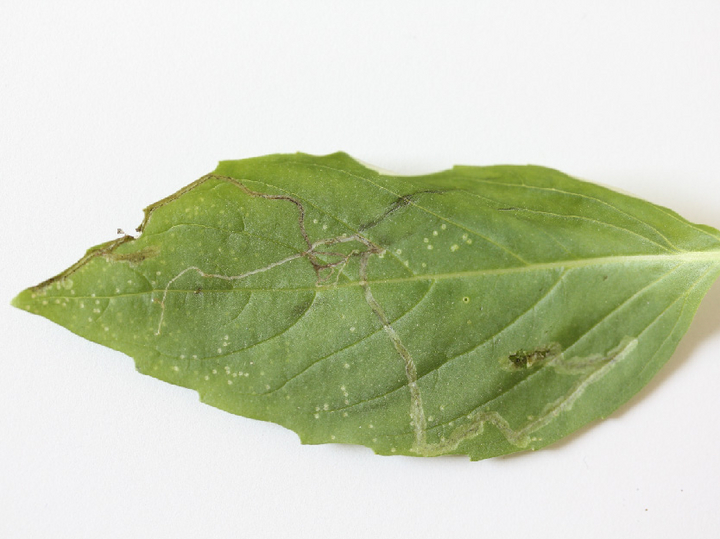Leaf miner flies
Liriomyza
Profile
The leaf miner family includes very small flies that occur on various vegetable and ornamental crops. Economically important leaf miners include Phytomyza and Napomyza species as well as Liriomyza species, some of which originate from subtropical countries and are listed as quarantine pests.
Appearance

Leaf miners of the genus Liriomyza are mostly black with a conspicuous yellow dorsal shield (scutellum). The eggs are not visible to the naked eye, as they are laid in the leaf surface in oviposition points. Only a small dot is visible, which cannot be distinguished from the sucking points. The larvae (maggots) are yellowish white in color and have no head capsule or legs. The barrel pupae are reddish to brown in color and about 2 mm in size.
Biology
Leaf miner flies lay eggs in the leaf surface and the larvae begin feeding in the leaf tissue immediately after hatching. The larvae produce the characteristic serpentine, light-colored mines (feeding tunnels) in the leaves by feeding inside the leaf. With the exception of L. huidobrensis (and the native leaf miner fly species), pupation always occurs outside the leaf tissue. These are found either attached to the outside of the leaf, on the soil, or just below the soil surface.
Damage symptoms

The most obvious indication of a leaf miner infestation are the leaf miner galleries in the leaves. Other clues and first signs of a leaf miner infestation are the bright, yellowish-white sucking and drilling spots on the leaves, which are produced by the female's ovipositor. The presence of the fly pupae on the outside of the leaf or on/in the soil (except pupae of L. huidobrensis) are also characteristics of a leaf miner fly infestation.
The feeding activity of the larvae destroys the leaf green between the leaf epidermis and the leaf hypodermis, thus limiting the photosynthetic capacity of the plant. This has a negative effect on plant growth and development. In severe infestations, the entire plant may die, especially young plants.
The leaf damage (leaf mines, sucking and drilling points) also affects the appearance and thus the quality (and value) of the plants, especially ornamental plants. In addition, sucking activities indirectly damage plants by promoting the entry of secondary pathogens.
Also significant is the role of leaf miner species L. sativae and L. trifolii as vectors of some plant viruses, including celery mosaic potyvirus.
Host plants
In general, all four Liriomyza species are polyphagous insects of ornamental and vegetable plants. Host plants from 65 different plant families are known.
The leaf vein miner fly(Liriomyza huidobrensis) is polyphagous, with host plants from 14 plant families, and lives on flowering plants, vegetable plants, as well as weeds.
The floridaminia fly(Liriomyza trifolii) is a polyphagous leaf miner species found on over 120 plant species (25 plant families), with preference for composite plants (Asteraceae). Its host plant range includes various ornamental plants, especially gerberas, as well as numerous vegetable plants.
The tomato leaf miner fly(Liriomyza bryoniae) has been described to be polyphagous on 16 plant families and is particularly found on plants from the composite, cruciferous (Brassicaceae), cucurbitaceous (Cucurbitaceae) or solanaceous (Solanaceae) families under glass.
Liriomyza sativae is a polyphagous species on ornamentals and vegetable crops, with host plants from nine families, preferentially on Solanaceae and Fabaceae.
Distribution
The leaf vein miner fly(L. huidobrensis) originates from Central and South America and reached Europe only in the late 1980s. Today it is still found in some countries of the EPPO region(also in Austria), in North America, Africa, Asia and Oceania.
The floridaminia fly(L. trifolii) originated in North America and is now widespread in America, Europe (including Austria), Africa, Asia and Oceania.
The tomato leaf miner fly(L. bryoniae) is the only European species. It is common in many areas of the EPPO region where there are crops under glass, and is found in Asia (Israel, Japan, Taiwan), North Africa (Egypt, Morocco), and the United States (Massachusetts).
Liriomyza sativae is the only species not yet present in the EPPO region, but otherwise distributed worldwide.
Prevention and control
- Thorough young plant control
- Prevention of influx in glass houses by closing the ventilation flaps with insect nets
- Monitoring and trapping by means of yellow boards/tapes
- Observance of general glasshouse hygiene
- Pick off infested plant parts in time to delay mass propagation. These plant parts should be chipped and composted under cover.
- Two native beneficial insects, the braconid wasp(Dacnusa sibirica) and the pea wasp(Diglyphus isaea), can be used effectively against leaf miners. These can be applied regularly in smaller amounts every two to three weeks as a preventive measure, depending on the infestation situation. Treatment can also be curative with an increased application rate and at least one repeat application within ten to 14 days.
- Nematodes of the species Steinernema feltiae, which are toxic to insects (entomopathogenic), can also be applied as foliar applications against leaf miner fly larvae.
- Treatment with approved plant protection products against leaf miner flies is possible. However, the rapid generation cycle of leaf miner flies and the fact that important developmental stages are well protected make control difficult and require several treatments (see list of plant protection products approved in Austria).
Phytosanitary status
L. huidobrensis, L. trifolii and L. bryoniae are listed as a Sanctuary Quarantine Pest(SQS) (Sanctuaries of Ireland and Northern Ireland).
L. sativae is listed as a Union Quarantine Pest (UQS).
Last updated: 12.09.2024
automatically translated